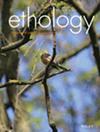Acoustic Features, Syllable Usage, and Song Rates of Male and Female Songs in a Tropical Island Songbird, the Puerto Rican Oriole
Abstract
Our understanding of elaborate signaling behaviors, such as bird song, has been hindered by historical biases towards male animals. Bird song has been shown to serve important functions like defending territories or attracting mates in both males and females, and singing in both sexes is likely the ancestral trait for songbirds. Female song is strongly associated with year-round territory defense, especially in the tropics. However, more studies of both male and female songs are needed to better understand the selection pressures acting on this elaborate signal trait. The common ancestor of the New World orioles (Icterus) was likely a nonmigratory tropical species, with both males and females singing and defending year-round territories. The Puerto Rican Oriole (Icterus portoricensis) has these natural history characteristics, but little is known about how each sex uses song in this understudied Caribbean endemic. We found that while male and female songs were significantly different acoustically, they were indistinguishable in the field, and showed no sex-specific pattern in syllable usage. Males sang at higher rates than females during the dawn chorus, but females sang frequently during the day. Song is likely evolving as a unified trait in this species, reflecting the characteristics of the common ancestor, but may serve different functions for each sex. In the future, playback studies and rate observations throughout the full day and throughout the year will provide additional insight into how males and females of this tropical songbird may be using their songs.


 求助内容:
求助内容: 应助结果提醒方式:
应助结果提醒方式:


